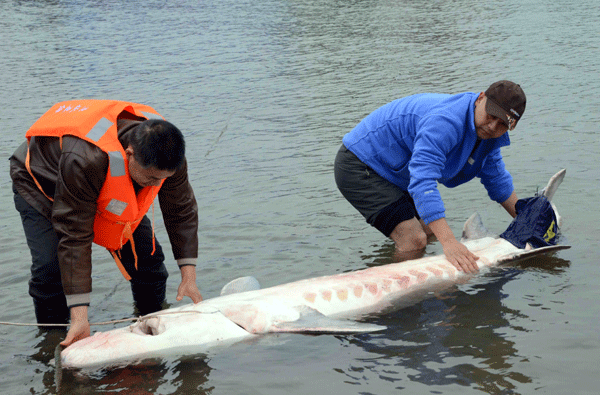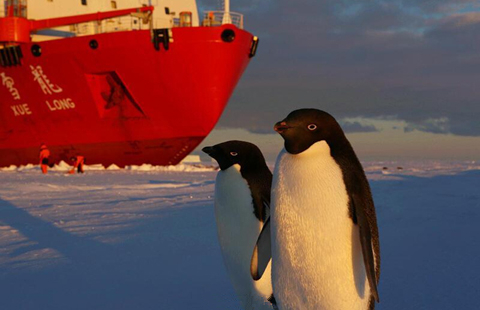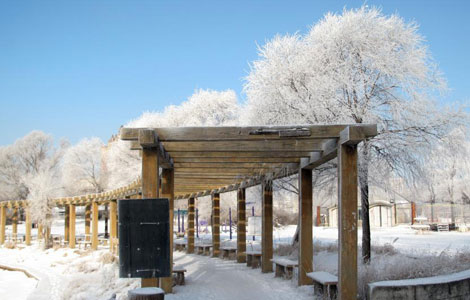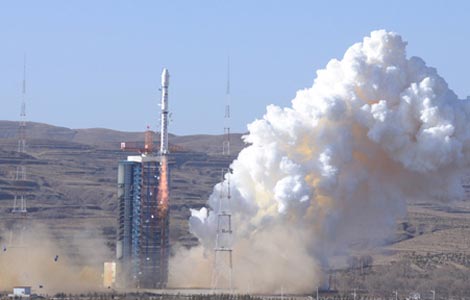The heat is on for the 'living fossil'
Updated: 2014-12-09 08:04
By Liu Kun in Wuhan and Wang Qian in Beijing(China Daily)
|
||||||||
 |
|
Experts attempt to rescue an injured wild Chinese sturgeon on the Yangtze River on Nov 25. Below: A 1.5meterlong wild Chinese sturgeon is pulled from the river in Nanchang, Jiangxi province, in May.CHENG LONGMEI / XINHUA AND LIU BAOPING / FOR CHINA DAILY |
Having spent more than three decades researching and protecting the wild Chinese sturgeon, Wei Qiwei can't stop worrying that this rare, ancient fish may become extinct in the coming decades.
In the past two years, researchers have discovered no evidence of natural reproductive activity in the Yangtze River for the first time since the species was first recorded in the 1980s, according to Wei, a researcher at the Chinese Academy of Fishery Sciences.
"If the wild fish cannot reproduce naturally, those currently alive will be the last of their kind," he said.
The academy's records show that before 2003, female sturgeons laid their eggs from late October to late November, but between 2003 and 2012, a number of factors resulted in the spawning season being delayed by a month, to later November and early December.
Although the researchers will continue to observe the fish, the chances of detecting sturgeon eggs in the section of the Yangtze River near Yichang, Hubei province - the site of the Three Gorges Dam - are slim.
"It's estimated that there are only about 100 sturgeons in the river now, compared with more than 2,000 in the early 1980s," Wei said.
Worsening environment
The Chinese sturgeon is one of the world's oldest living species, dating back to the days of the dinosaurs about 140 million years ago. But despite its long lineage, the fish may not survive much longer, according to Wei, who warned that its extinction may be one of the prices China pays for its rapid economic development, especially the surging dams and bridges built over the Yangtze River.
The optimum water temperature for the sturgeon to reproduce is between 15.3 C and 20.2 C, but as heated water stored in the Three Gorges Dam is released into the Yangtze River, the average temperature has risen and affected the reproductive cycle, according to Wei.
"The Three Gorges Dam and others built in the river system are affecting egg laying because the water discharged from them has absorbed heat during storage, and that's raised the water temperature downstream," he said.
Gao Yong, deputy director of the China Sturgeon Institute, said global warming has also contributed to the temperature change in the river.
The hydropower project, which started in 1993, includes a 185-meter-high dam, a five-tier ship lock, 26 hydro-powered turbo-generators, and six subterranean generators that were installed in 2012. The river's average water level was also raised, from 88 meters above sea level to 135 meters in 2003, and then to 175 m in 2010.
Wei said the dam-building projects have reduced the number of spawning sites: "Following the construction of the Gezhouba Dam in Yichang, only one spawning site is left for the sturgeons."
Ma Jun, director of the Institute of Public and Environmental Affairs, an NGO in Beijing, said in a previous interview that if the habitat continues to shrink, the aquatic ecosystem near the dam will be completely destroyed.
Jiang Wei, a researcher with the China Sturgeon Institute, said the destruction of the natural habitat and environmental degradation are making it hard for the sturgeons to survive.
- Chinese sturgeon risk extinction after dam construction
- Giant sturgeon found dead
- 8,000 sturgeon released into Yangtze
- Sturgeon's death highlights threat to ancient fish
- Sturgeon farming on a bigger scale
- Urging the sturgeon's recovery
- Rare Chinese sturgeon under threat at Three Gorges
- World's 1st artificially bred sturgeon born in China

 Penguins attracted to Chinese icebreaker Xuelong
Penguins attracted to Chinese icebreaker Xuelong
 Prince William and Kate arrive on first trip to NYC
Prince William and Kate arrive on first trip to NYC
 Welcome aboard
Welcome aboard
 Female VIPs steal the spotlight in 2014
Female VIPs steal the spotlight in 2014
 Later arrival of rime still an attraction in Jilin
Later arrival of rime still an attraction in Jilin
 'Big' Peking opera staged in New York
'Big' Peking opera staged in New York
 China, Brazil pledge to promote science, technology co-op
China, Brazil pledge to promote science, technology co-op
 ZTE, NBA team partners in business, charity
ZTE, NBA team partners in business, charity
Most Viewed
Editor's Picks

|

|

|

|

|

|
Today's Top News
UN welcomes China pitching in on climate change
China's economy 'poised to face increased pressure'
Hard lesson learned as market continues to rise
China's supreme court backs Zhou's Party expulsion
Renminbi gets ready to play a bigger role
Mobile spending picks up speed
American Wild West hits China
Confucius Institutes defended after US debate
US Weekly

|

|







